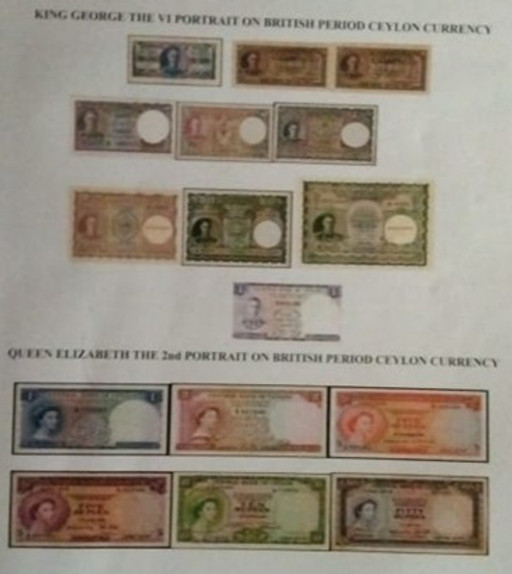Pre-Independence Currency Note of Ceylon – British Period
The History of British Ceylon began in 1815 When the Kandyan Kingdom fell into the hands of British. it ended over 2300 years of Sinhalese monarchy rule on the Island. The British rule on the island lasted until 1948 when the country gained Independence Currency was issued by the Ceylon Government treasurer in Rs dollar till 1825. The British Pound became Ceylon official Currency in 1825, replacing the Rix Dollar of Ceylon. From 1827 currency note were issued in pound sterling The bank of Ceylon commenced issuing banknotes in Sri Lanka in 1844 replacing the Existing treasury notes in 1856. The Rupee was established as unlimited legal tender for Ceylon in 1869 and became the sole legal tender for Ceylon in 1872. Ceylon gained independence in 1948 , and Introduced the new Central Bank of Ceylon was establish by the monarchy law act (MLA) No 58 of 1949 and commenced operation on 28 August 1950 The Government of Ceylon introduced its first rupee banknote issue in 1885 , A five rupee note (1885-1925) was followed by 10 rupee (1917 – 1939) two rupee (1899-1915) A second issue included the one rupee(1917- 1921) two rupee (1899 and 1919) notes During the 1920s ( and in some cases the 1930 s) the one rupee (mentioned above )two rupee ( 1925 -28 and(1929-39) two types of 10 rupee (1927-28) and 1929-39),50 rupees (1929-1939) 1oo rupee1926-39, 500 rupees (1926) and 1000 rupees (1929 ) notes were all in circulation. Thera were two issues in 1941. carrying the portrait of King George 6th (14 December of1895- 6th of February 1952) The first considered of one, two, five, ten-rupee banknote issued only in 1941 Through issued slightly earlier a 1000 rupee note (1938) has been grouped with this issue. The 1941 second issues considered of one (1941 -49), two (1941-49) five (1941-1949), ten (1941-1946), (1941-45), 1000(1941) and 10000 rupees (1947) notes The 10000 rupee note was used for Interbank Transaction only In 1942 fractional bank note issues were introduced . A 25 and 50 cents notes (1942) were followed by a second issues 5 cents (1942-43) 25 cent (1942-49), and 50 cents notes (1942-49) In 1942, emergency issues for 5, 10,25 and 50 cents were introduced and issued until 1949 Ceylon gained independence in 1984. in the central bank of Ceylon took over the issuance of paper money. Introducing 1- and 10-rupees notes carrying the portrait of King George sixth (Albert Fredric Arthur George, 14th of December 1895 – (6th of February 1952) were followed in 19by 2,5-,50- and 100-rupee notes. the five rupees note was not issued in 1953 and the 10 – rupee note was issued 1953 and1954 the Portrait of a young Queen Elizabeth, as the Head of the Common wealth of nations, which included Ceylon was seen on this series of Currency notes. the portrait of queen Elisabeth II was replaced with the Ceylon Armorial ensign with the 1956 currency note Issues




 Prefects
Prefects